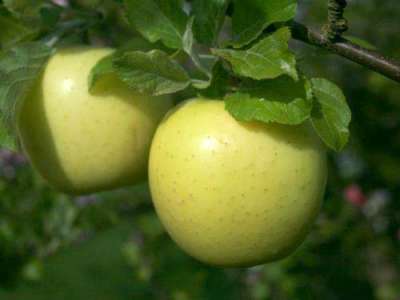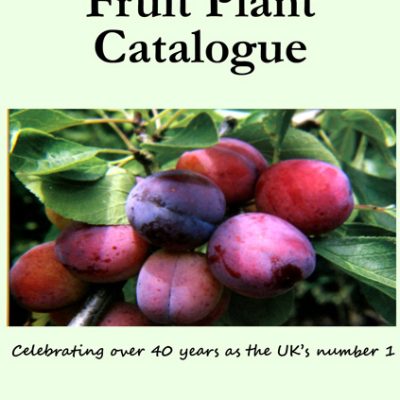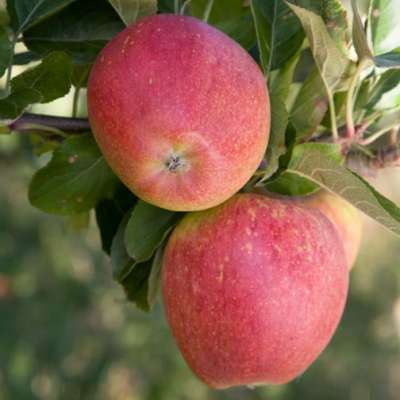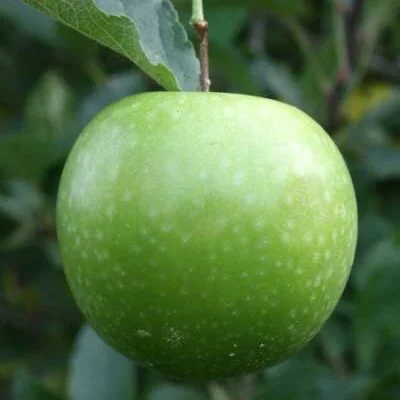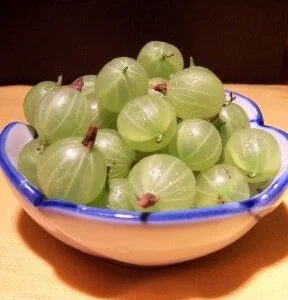Your basket is currently empty!
Growing Fruit on the Patio
- Some Practicalities
- Apple Trees for the Patio
- Pears
- Plums, Gages & Damsons
- Cherries
- Peaches & Nectarines
- Mulberries
- Figs
- The Value of the Vertical Accent
Patio Fruit – An Introduction
Growing fruit close at hand on the patio or paved area is both an extremely attractive proposition – and a practical one too. With gardens growing ever smaller the increased yield and the diversity of the crops that can be grown there is valuable indeed. Plus it is far easier to protect the fruits from pests when grown nearer to the house, and to harvest the crops at the optimum time.
Fruit trees and fruiting plants are, by there very nature, attractive. The concept of arching boughs laden with tempting slowly ripening fruit is in itself tempting & satisfying. Plus the joy of fragrant early Spring orchard blossom produced on a scaled down miniature tree is an unrivalled delight. With the advent of a host of miniature rootstocks that now covers most types of fruit tree it has never been easier to cultivate fruit trees in pots. There is really no limit to the range that can be grown – it has been said that absolutely any plant or tree of any kind can be grown in a container – here I concentrate on those that are the most appropriate the most attractive and which will give the most pleasure and reward.
Some practicalities
Choose a size of container that is right for the crops you are growing. The majority of fruit trees on miniature rootstocks will require a container not less than 18″ in depth and circumference; up to 24″ is ideal. Absolutely any type of container is suitable as long as it is adequately drained. Terracotta is the most aesthetically pleasing but the genuinely frost-proof kinds are expensive; plastic is perfectly acceptable as are wooden barrels. The compost we would recommend for trees is soil based compost such as John Innes no 2. It has more heart than a peat based compost and will provide a more satisfying long-term medium for a tree. Such trees can remain container subjects indefinitely; after 5-7 years or when yields start to diminish, the tree can be removed from its present container when it is dormant, tease some of the roots out and remove some of the old compost and re-pot and top dress with fresh. The tree will be rejuvenated and start to perform to it its greatest capacity again.
Smaller subjects such as soft fruits will be more appropriately planted in a good proprietary general purpose or container compost that is peat based. A container of around 15″ is adequate for a single soft fruit bush such as a currant or gooseberry. Subsequent feeding is of course important for all long-term subjects. The easiest way to provide adequate nutrition to ensure continuing good crops is by the use of those handy singular Osmocote tablets. One or two tablets will last the entire season and provide all that is necessary for good health and productivity. You might also care to provide additional feed with a good foliar feed such as Maxicrop which is a type of seaweed extract. The benefit of the latter is that it also enhances the foliage and makes it look particularly lush and pleasing.
The number one priority for all containerised subjects is of course that of watering. During the growing season it will be necessary to water well each day with a hose or large watering can. This can be time consuming if a number of subjects are being grown so it might be wise to invest in one of the many automatic systems available or perhaps a length of ‘leaky hose’ as it is called. Remember that during the summer even if it has rained it may still be necessary to water by hand because the area of compost exposed to the rain is relatively small and the foliage canopy often stops most the rain from penetrating. Plants and trees in pots need more water because the compost heats up much more than the soil in the ground does.
Apples
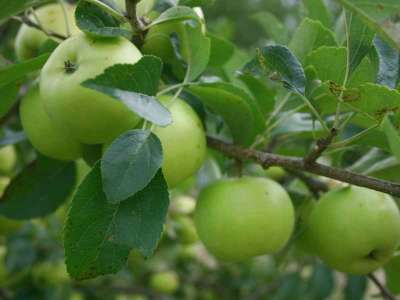
Best time to plant apple trees UK – Apples on the M27 rootstock make charmingly picturesque naturally miniature trees that look like perfect scaled down miniature orchard trees. Crops can be very heavy – up to 30ibs per tree when fully established, and they yield early in life too, often from the first season. The fruits actually tend to be larger than they would normally be too and maintain the genuine characteristics & flavour of the variety chosen.
After the first year or two little pruning is required and these tend to be very low maintenance subjects. The joy of scented appleblossom on the patio is incomparable! You can choose any variety that pleases you on the M27 stock as long as the basic pollination requirements are observed. You may to stick to those that are self fertile to avoid such considerations and these do also tend to be the most satisfactory varieties. Our choice would be Limelight, Greensleeves, Saturn, Redsleeves, Red Falstaff, Hereford Russet and Red Windsor – and the self fertile form of Cox’s Orange is also suitable.
There are no self pollinating cookers at present but Bountiful is easily pollinated by any of the above and a precocious compact little tree. Where a range of apples is being grown together in pots then you could consider a Bramleys Seedling and it makes a phenomenal tree on the miniature M27.
Pears
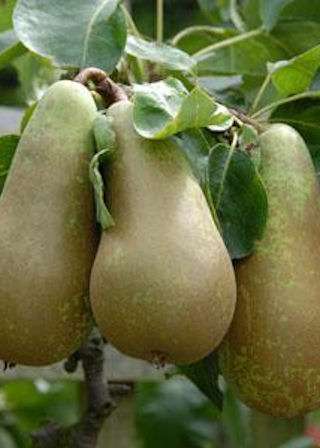
There is one number one choice for a Pear tree on the patio and that has to be Concorde.It is a naturally compact short jointed little tree that is self fertile and heavy yielding.On the Quince C rootstock is it very easily contained and precocious too Its flavour is sweet and moreishand the many fruits ripen from early October. You might also wish to grow the stalwart Conference on the Quince Crootstock (an explanation of rootstocks can be found here) and this too is self fertile.If your hankering is for the delectably sweet and juicy Williams type pearthen this variety can be grown with the companionship of either of the above varieties for pollination, again onthe Quince C rootstock which remains the most compact stock for Pears.
Such trees can be kept to 6-8′ in a containerand actually seem to yield more heavily than counterparts grown in the open ground. Pear blossom is very early andthe most prone to late frost damage; as the climate near to the house is just that little bit warmer they are morelikely to escape damage – and it is also more convenient to grow some fleece or sheeting over the tree if the nightthreatens to be cold.
Plums, Gages & Damsons
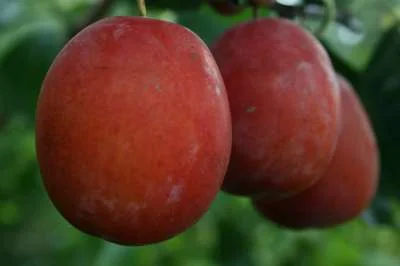
These are all inter-related and all are grafted onto the superb ‘Pixy’ rootstock which has at last made it very possible to cultivate these mostdelicious and versatile of fruits in a container, a practice that had hitherto been impossible. Most gardeners consider the concept of their very owndwarfing Victoria plum – considered the queen of all plums – in a pot on the patio as the ultimate gardening joy. However consider a number of variationsthat can be enjoyed. Victoria itself ripens mid-late August; why not ring the changes with the useful little ‘Opal’ which ripens much earlier from lateJuly. This jolly little scarlet and yellow plum has an excellent flavour and can be enjoyed for dessert or culinary purposes. At the other end of theseason the majestic large Marjorie’s Seedling plum ripens very late in late September bringing first quality fresh plums deep into the Autumn. Its juicygolden flesh is well flavoured and suitable for all purposes; this variety is also self fertile.
Another Plum variety highly recommended on Pixy is Jubilee. This super-hardy Swedish raised variety is possibly the finest plum tree ofall for general cultivation and it excels on Pixy rootstock. It’s self fertile and the quality fruits tend to be much larger than Victoria;its eating qualities are similar and Jubilee is definitely the most reliable Plumvariety you can grow.
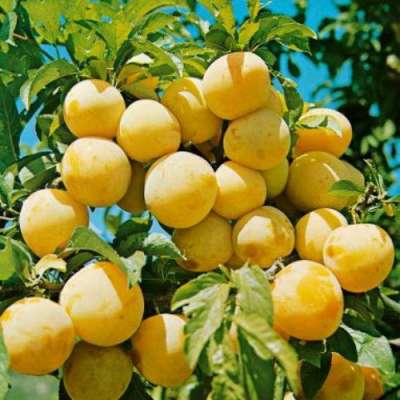
Gages tend to do well on the patio because these are fruit trees that enjoy the maximum amount of sunshine and a warmer atmosphere -both tend to abound on the Patio. A freshly picked Greengage is a delectable joy indeed. The Oullins Golden Gage is the sweetest by far and is also selffertile and would be our first choice of variety. A secondary recommendation is the new Stella’s Star, a precocious and compact variety that is bound to dowell in a container.
Lastly you may have a desire for an old fashioned Damson tree, the fruits of which are blessed with such an intense flavour that canbe turned into wondrous pies and preserves. Damsons are hardly ever available to buy in the shops. The Shropshire Damson makes a dense twiggy little treethat generously produces a host of small deep black purple blue-bloomed fruits all along the branches. Ripening in September, this Damson is self fertileand easy to grow.
Cherries
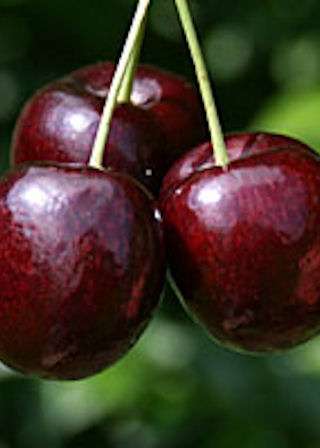
The new Gisele 5 rootstock has revolutionised the growing of Cherries in the UK. The first reliable and genuinely dwarf/miniature stock for Cherries has ensured that these most delectable of fruits are now within the scope of all to grow and that the fruiting Cherry tree has firmly been brought into the realms of patio growing. Gisele loves being cultivated in a pot; within only 2 years these precious and fast-maturing little trees become laden with boughs dripping with the most tempting fruit! The combination of Gisele and a host of more recent reliable self fertile varieties has resulted in the ideal patio tree. Such trees will mature to only 5-6′ in a pot.
Sunburst, Summer Sun and Lapins are all large black dessert cherries with impressive quantities of juice and very sweet flavour. Stella is an older variety which still deserves the widest cultivation. Its large deep dark red fleshy fruits have an outstanding flavour. You might also like to try an acid cherry for the production of wondrous cherry pies preserves and juices; when was the last time you saw cooking cherries available to buy in the shops? Its got to be worth cultivating a Morello! All of these varieties are self fertile and on the Gisele rootstock will require the minimum of pruning.
Peaches & Nectarines
These fruits were just made for the patio. Not only are they rather attractive with early large rose pink blossom but they are naturally compact as well and probably at their best when grown in containers. There is a preconception that they might be a little tender but they are infact entirely hardy. They are all also self pollinating so there are no pollination requirements to take into account. Peaches and Nectarines are precocious, almost invariably yielding the first summer following planting. You will be genuinely amazed at the difference in texture and flavour between your own home-grown produce and those you buy in the shops. Shop and supermarket specimens of Peaches and Nectarines have suffered alarmingly at the hands of commercial cultivation. Because they are difficult to transport they are harvested far too early, before the flavour, sugars and juice content have developed properly, and this is why the texture is so often rubbery or dry, and the flavour dull and tart. Left to ripen fully on the boughs, and freshly picked and eaten in the summer sunshine, your own Peach and Nectarine yield will, we promise you, be a revelation.
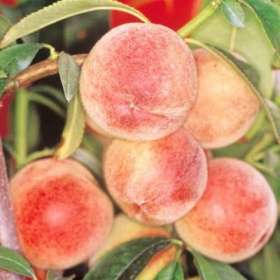
The number one most popular, famous and satisfactory Peach is a variety called Peregrine. That it is white fleshed as well – the sweetest most ambrosial kind – only cements its reputation still further. Other varieties provide a welcome addition to the range – Red Haven produces sumptuously coloured velvet-skinned beauties, and Rochesterhas a mouthwateringly deep and tender golden flesh; Amsden June too is well worth mentioning because it is very early ripening and finely flavoured too. Amongst the Nectarines look no further then Lord Napier which is by far the most reliable cultivar.
The above varieties can all be maintained at an even 6-7′ in a container, with ease and they will provide 20-30 full sized fruits when established. There are however, also 2 truly miniature varieties you might like to consider. Garden Lady [Peach] and Nectarella [Nectarine] are naturally miniature with a formal rounded head grafted onto a perfect small standard stem of 3.5′ in height. They produce full sized fruits and whilst not as heavy cropping as the above, they were just made for the patio and do not require any pruning whatsoever, being naturally dwarf.
Peaches and Nectarines do have one Achilles heel that needs attention. They will almost certainly get a disease called Peach Leaf curl, unless protected from it. This disease is not fatal, nor does it affect cropping too much; however it is rather disfiguring. The easiest way to keep your trees free from it is to protect the newly emerging leaves from water [as the spores are spread by water or moisture] by moving them under cover as the leaves emerge, or covering for a week or two with a sheet. You can also spray against it with a copper based fungicide. This needs to be applied very early, before the leaves start to emerge, as well as during. Once the leaves are fully emerged then the trees are usually safe from the disease. This disease is relatively easy to avoid and even if the worst comes to the worst and your tree[s] get it, it is invariably shrugged off as the season progresses so don’t let it discourage you from growing these hugely rewarding and otherwise easy fruit trees.

Mulberries
Very slow growing trees of character, they adapt very well to container growing. The large fringed leaves are attractive and turn to rich golden amber in the Autumn and the trunk becomes fissured and textured as it ages. The Black Mulberry [Morus Nigra] the white Mulberry [Morus alba] and their varieties are all equally suited. Black Mulberries are the most prized and have an intense, sharp flavour that makes fantastic preserves and pies, and can also be simmered and served with vanilla ice cream! The White Mulberry is milder and sweeter. As the fruits of Mulberry trees will attract the neighbouring Blackbird population like a magnet the trees are much easier to keep an eye on when grown close to the home and the trees much easier to net when grown in a container. An interesting and elegant variation is to grow the Weeping White Mulberry in a container; its waterfall like cascading curtain of glossy foliaged stems forms a striking mushroom headed tree and it will crop with quantities of sweet pinkish white fruits.
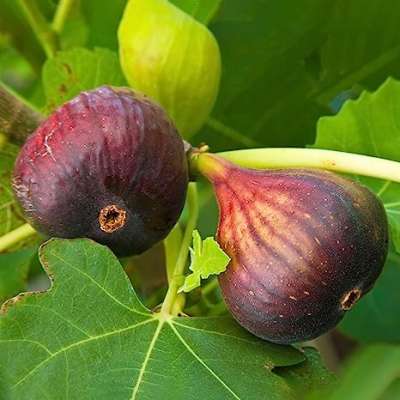
Figs
Figs love being restricted in a container and actually crop more heavily because of it. They are so attractive with their attractivelarge lobed leaves, extremely easy and undemanding,and will crop virtually from the word go. The later fruits will ripen fully inthe Autumn with the benefit of a warm sunny patio. All varieties are suitable. Brown Turkey is always considered the most prolific and by far the most oft-grown.
The Value of the Vertical Accent
Climbing Fruiting Plants
There are a number of climbing fruiting plants that you can train up posts, arch or the pergola/gazebo or even around the doorway. Grapes, Tayberries, [especially the thornfree Buckingham] thornless Blackberry and Loganberry all make fine subjects. The ornamental Kiwi fruit or Chinese Gooseberry, with its large felt-like heart shaped leaves is also ideal and extremely attractive. Remember to plant a male and female vine for fruiting potential as they always like to be planted in pairs. The Japanese Wineberry too is worthy of planting as an ornamental, with its striking bristly red stems making an attractive feature especially in the winter. The vermillion berries are served as a decadent treat sprinkled with a little red wine! The above are all easy to grow, train and tie in as you see fit and to accommodate in the available space.
Soft fruits
Currant bushes and gooseberries are not, let’s face it, terribly attractive. However there is no practical reason why they should not be grown in containers, if desired and all varieties are suitable. Blackcurrants, Whitecurrants, Red’s and Goosberries are all easy to grow in containers. With gooseberries it might be a good idea to stick to the thornless variety ‘Pax’.
Blueberries
Possibly the most ideal of all fruiting plants for the patio, with the twin advantages of elegant beauty and a precocious free-fruiting liking for containers. Blueberries are virtually alone in the fruiting plant world in requiring an acid/ericaceous compost or soil. This is easy to satisfy in the confines of a container – simply buy a bag of proprietary ericaceous compost. Use a 15″ pot and away you go. Blueberries nearly always fruit the summer following planting.
As they are extremely expensive to buy in the shops there is a strong economic argument for growing your own, with an established bush yielding several pounds of fruit for years and years. Blueberries are often planted for their ornamental value; the drooping pearl-white bell flowers in May and the vivid scarlet orange and ochre-gold Autumn leaf colours rival many an ornamental shrub. These are tidy upright, twiggy growers than need little or no pruning and are perfectly simple to grow and, with commercial plantations of many years standing in Poland – entirely hardy too!
Strawberries
One of the most popular of fruits for the Patio. They are versatile and can be grown in a number of ways. They can be planted as an understorey to miniature fruit trees, in grow bags on their own, in a hanging basket, or in tubs. All varieties are suitable and the basic cultivation requirements contained in our Cultural Guide Booklet [included with all orders] observed. The pants should only be cropped for one season when grown in any containers, and then planted out or replaced. With planning you can pick ripe strawberries from your garden from late May right through to the frosts by planting a range of varieties. Emily is the very earliest ripening in May; Honey and Cambridge Vigour provide standard early fruits, Pegasus/Eros and Elsanta are maincrop varieties, and Aromel will yield from August right through the Autumn, especially with protection.
I hope the above has whetted your appetite to embark on the whole-new-world that is growing fruit on the patio; the possibilities really are almost endless and, as mentioned previously, if your favourites aren’t described above don’t be discouraged – you really can grow anything in a container.



